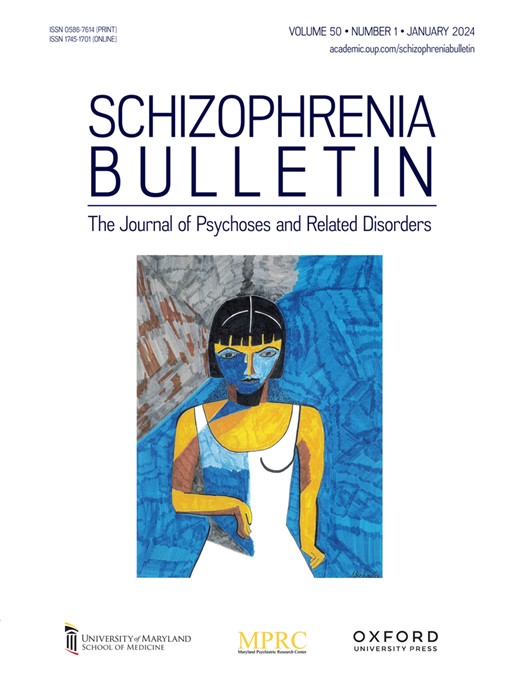Large-Scale Public Stigma Reduction Toward Individuals With Psychosis Using Brief Videos: A Secondary Data Analysis
IF 4.8
1区 医学
Q1 PSYCHIATRY
引用次数: 0
Abstract
Background Stigma toward individuals living with psychosis impacts treatment seeking and outcomes among youth. Brief social contact-based video interventions (<3 min long) can be disseminated via social media to reduce stigma. However, it is unclear how these videos impact distinct components of stigma (negative attitudes and behavioral intentions) and whether matching on demographic characteristics (race and gender) between protagonist and viewer bolsters effects. Study Design and Hypothesis We explored these questions in a secondary data analysis of 6 prior randomized controlled trials varying in presenter characteristics (race, gender, lived experience, actor) and video modality (selfie vs traditional style) in 6946 United States youth, ages 18-30, recruited via Prolific. It was hypothesized that our results would replicate previous findings on efficacy of brief videos on reducing stigma and that there would be a significant impact on cognitive and behavioral subdomains and a matching effect for gender and race. Study Results Results replicated prior findings that video interventions were effective at reducing stigma across 5 domains (social distance, stereotyping, separateness, social restriction, and perceived recovery) and contributed to an overall shift in stigmatizing attitudes and behavioral intentions at post-intervention and 30-day follow-up. Videos that matched viewers’ gender or race had significantly stronger stigma-reduction effects on certain domains, though effect sizes were small. Study Conclusions Results highlight that brief, easy-to-disseminate videos can effectively change stigmatizing perceptions and behavioral intentions toward individuals with psychosis. Future studies should explore how behavioral intentions translate to action and the impact of matching between presenters and participants.使用简短视频大规模减少公众对精神病患者的耻辱感:二次数据分析
背景:对精神病患者的耻辱感会影响青少年的治疗寻求和结果。简短的基于社交接触的视频干预(长3分钟)可以通过社交媒体传播,以减少耻辱感。然而,目前尚不清楚这些视频如何影响污名的不同组成部分(消极态度和行为意图),以及主角和观众之间的人口统计学特征(种族和性别)匹配是否会增强效果。研究设计和假设我们通过对6项随机对照试验的二次数据分析探讨了这些问题,这些试验在演讲者特征(种族、性别、生活经历、演员)和视频形式(自拍与传统风格)方面各不相同,共有6946名年龄在18-30岁的美国年轻人通过高产网站招募。假设我们的研究结果与之前的研究结果一致,即简短视频对减少耻辱感的效果,并对认知和行为子域产生重大影响,并对性别和种族产生匹配效应。研究结果重复了先前的研究结果,即视频干预在5个领域(社会距离、刻板印象、分离、社会限制和感知恢复)中有效减少了耻辱感,并有助于在干预后和30天随访期间耻辱感态度和行为意图的总体转变。与观众的性别或种族相匹配的视频在某些领域有明显更强的减少耻辱的效果,尽管效果很小。研究结果强调,简短、易于传播的视频可以有效地改变对精神病患者的污名化认知和行为意图。未来的研究应该探讨行为意图如何转化为行动,以及演讲者和参与者之间匹配的影响。
本文章由计算机程序翻译,如有差异,请以英文原文为准。
求助全文
约1分钟内获得全文
求助全文
来源期刊

Schizophrenia Bulletin
医学-精神病学
CiteScore
11.40
自引率
6.10%
发文量
163
审稿时长
4-8 weeks
期刊介绍:
Schizophrenia Bulletin seeks to review recent developments and empirically based hypotheses regarding the etiology and treatment of schizophrenia. We view the field as broad and deep, and will publish new knowledge ranging from the molecular basis to social and cultural factors. We will give new emphasis to translational reports which simultaneously highlight basic neurobiological mechanisms and clinical manifestations. Some of the Bulletin content is invited as special features or manuscripts organized as a theme by special guest editors. Most pages of the Bulletin are devoted to unsolicited manuscripts of high quality that report original data or where we can provide a special venue for a major study or workshop report. Supplement issues are sometimes provided for manuscripts reporting from a recent conference.
 求助内容:
求助内容: 应助结果提醒方式:
应助结果提醒方式:


